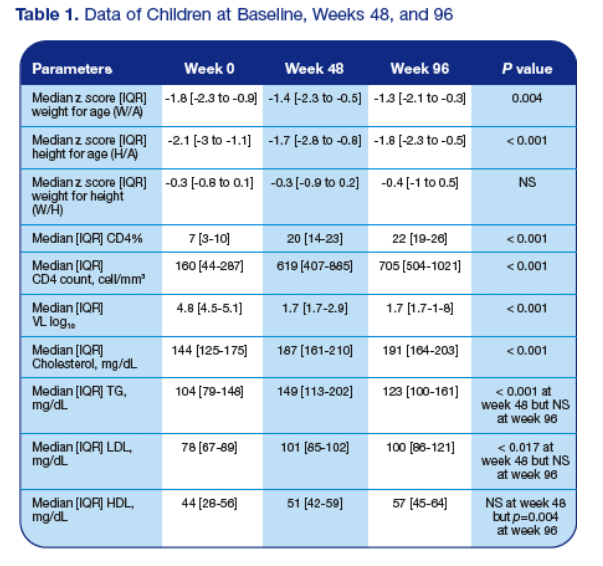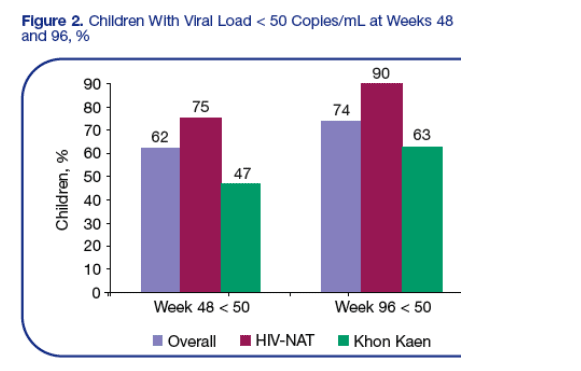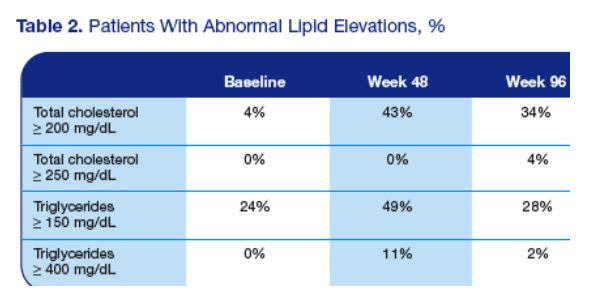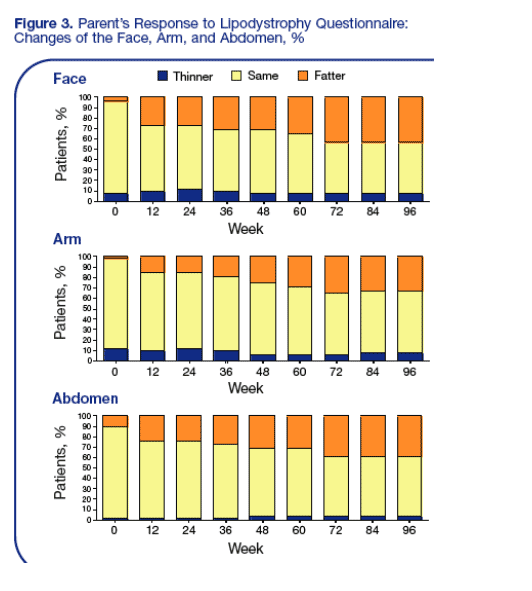 |
 |
 |
| |
Efficacy and Safety of Double-Boosted Saquinavir (SQV)/Lopinavir/Ritonavir (LPV/r) in Nucleoside Pretreated Children at 96 Weeks
|
| |
| |
Reported by Jules Levin
15th CROI, Feb 3-6, 2008, Boston
Torsak Bunupuradah1, Pope Kosalaraksa2, Chulapan Engchanil2, Pitch Boonrak1, Tawan Hirunyanulux1, Sasiwimol Ubolyam1, Pagakrong Lumbiganon2,
Kiat Ruxrungtham1,3, Emily Labriola-Tompkins4, Jintanat Ananworanich1,5, and HIV-NAT 017 Study Team
1The HIV Netherlands Australia Thailand Research Collaboration (HIV-NAT), Bangkok, Thailand; 2Khon Kaen University, Khon Kaen, Thailand; 3Chulalongkorn University, Bangkok, Thailand;
4Roche, Nutley, NJ, USA; 5South East Asia Research Collaboration with University of Hawaii (SEARCH), Bangkok, Thailand
Conclusion
· Double-boosted SQV/LPV/r showed significant CD4 rise and VL decline at 96 weeks
· Rates of virological suppression and hyperlipidemia were comparable to other studies using LPV/r in combination with NRTIs in children1-3 and to an adult study using double boosted SQV/LPV/r6
· Side effects were common but mild in severity
· HDL was significantly increased without elevations of TG and LDL
BACKGROUND
Children failing nucleoside reverse transcription inhibitor (NRTI)/nonnucleoside reverse transcription inhibitor (NNRTI) regimens have limited options for
second-line therapy.1-3
Our previous report of the first 20 children enrolled in this study at 24 weeks showed satisfactory pharmacokinetic parameters of saquinavir (SQV)/lopinavir/ ritonavir (LPV/r) and viral load (VL) suppression rate (80% and 60% having VL below 400 and 50 copies/mL respectively).4
Thai Ministry of Public Health guidelines recommend SQV/LPV/r as an alternative option for NNRTI-failing patients with significant NRTI resistance.5
Objective
To assess the 96-week efficacy and safety of double-boosted SQV/LPV/r combination in children who have failed NRTI/NNRTI-based regimens.
Sites
· HIVNAT in Bangkok (Site 1)
· Khon Kaen University in Khon Kaen (Site 2), Northeast Thailand
Methods
The HIV-NAT 0174 trial enrolled 50 HIV-1-infected children who were protease-inhibitor (PI)-naive and failing NRTI or NRTI / NNRTI-based treatment. The children were followed for 96 weeks.
Inclusion Criteria:
1. HIV-1 infected children
2. PI-naive and failing NRTI- or NRTI / NNRTI-based treatment
3. Age under 16 years
4. Able to swallow pills
ARV and Dosage:
· LPV/r was dosed at 230/57.5 mg/m2 BID, provided as adult capsules (LPV/r 133/33 mg) and supplemented with oral solution containing LPV/r 80/20 mg/mL
· SQV was dosed at 50 mg/kg BID provided as 200 mg SQV mesylate capsules and 500 mg tablets
· Lamivudine (3TC) 4 mg/kg BID was added in patients who had no prior exposure
Follow up schedule
At baseline and weeks 4, 8, 12, 24, 36, and 48
Assessments:
Every 12 weeks for:
· Clinical assessment
· CD4 count: absolute and percent
· HIV RNA (Roche Amplicor Ultrasensitive assay, Palo Alto, USA)
· Haematology, clinical chemistry, and adverse events
Every 24 weeks for:
· Fasting lipids (triglycerides [TG], low density lipoprotein [LDL], and high density lipoprotein [HDL])
· Lipodystrophy was assessed by standard questionnaire Clinical and laboratory adverse events (AEs) were graded by DAIDS toxicity 2004
Definitions:
Virological failure (VF): having 2 consecutive VLs > 400 copies/mL after week 12
Intention-to-treat analysis was performed
Results
Baseline characteristics (Table 1)
· Median age 9.3 years (intraquartile range [IQR] 7.1-11.2)
· Female: 56%
· % CDC classification N:A:B:C = 4:14:68:14
· No significant difference in baseline characteristics between both sites except baseline VL was significantly higher at the Khon Kaen site (p=0.037)
· Prior NRTI treatment included zidovudine for 56%, lamivudine for 34%, stavudine for 26%, and didanosine for 38%
· 21/50 Children (42%) were NNRTI-pretreated
· 17 Children received 3TC
· 46 (92%) Children had genotyping done. The median number of nucleoside associated mutations (NAMs), excluding M184V, was 3 NAMs. Twenty-one children (51%) had ≥ 4 NAMs


By week 96
· 3 Patients had died from bacterial infection (one died within the first 2 weeks, one died within the first 3 months, and one at week 36) and 2 stopped ARV from
intolerance and noncompliance
· 3 Had herpes simplex infection, 2 had pulmonary tuberculosis, 1 had varicella infection
· No child had progressed in their CDC classification
· Significant rises of CD4% and CD4 count were seen
(Table 1 and Figure 1)
· Median VL reduction was -2.88 log10 (IQR -3.3 to -2.8), p<0.001

· Thirty-nine (78.0%) and 37 (74.0%) children achieved VL < 400 and < 50 copies/mL with significant differences between sites (Site 1: 90% and 90%;
Site 2: 70% and 63%, respectively) (Figure 2)
· VF was seen in 1/20 children at Site 1 and 5/30 children at Site 2; 3 failures had poor adherence
· ARV-related AEs of any grade were seen in 10 children (20%); grade I-II: 61%; grade III-IV: 39%
· The most common AEs were diarrhea, vomiting, and elevated TG
· There were no significant changes in lipids (Tables 1 and 2).

· From parental assessments, approximately half reported no change in body shape, and 33%, 43%, and 39% reported fatter arms, face, and abdomen, respectively, among the children (Figure 3)
· Higher SQV and LPV minimum concentrations were seen in this cohort of children compared to reported data in Caucasians, suggesting that lower PI dosages can be used in Thai children (Please see poster 575)

References
1. Delaugerre C, et al. Predictive factors of virologic success in HIV-1-infected children treated with lopinavir/ritonavir. J Acquir Immune Defic Syndr. 2004;37(2):1269-1275.
2. Resino S, et al. Salvage lopinavir-ritonavir therapy in human immunodeficiency virus-infected children. Pediatr Infect Dis J. 2004;23(10):923-930.
3. Ramos JT, et al. Safety and antiviral response at 12 months of lopinavir/ritonavir therapy in human immunodeficiency virus-1-infected children experienced with three classes of antiretrovirals. Pediatr Infect Dis J. 2005;24(10):867-873.
4. Ananworanich J, et al. Pharmacokinetics and 24-week efficacy/safety of dual boosted saquinavir/lopinavir/ritonavir in nucleoside pre-treated children. Ped Infect Dis. 2005:24:874-879.
5. Ministry of Public Health Thailand National guidelines for the clinical management of HIV infection in children and adults. Bangkok, 2007.
6. Hellinger J, et al. Pilot study of saquinavir and lopinavir/ritonavir twice daily in protease inhibitor-naive HIV-positive patients. HIV Clin Trials. 2005;6(2):107-117.
|
| |
|
 |
 |
|
|